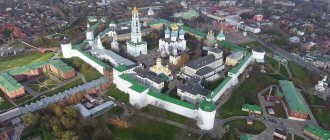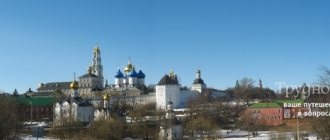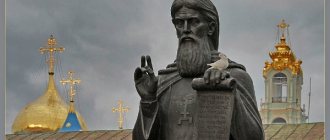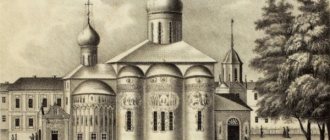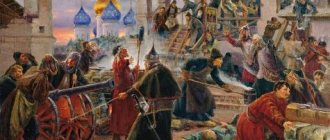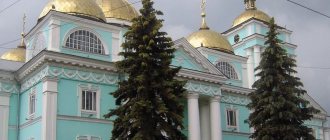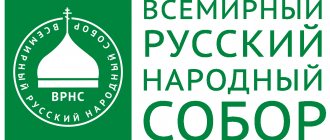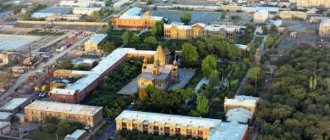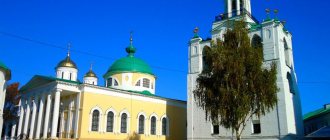The Trinity Lavra of St. Sergius is a monastery that arose on a hill called Makovits in the 14th century. It was founded by the Russian monarch - Sergius of Radonezh. It was here that the abbot blessed the Battle of Kulikovo led by Prince Dmitry Donskoy. Subsequently, the governor returned here again to commemorate the dead. The place has had a complicated history. In 1704 it was almost completely destroyed. The Tatar Khan burned it to the ground. Then the structure was completely restored and the next 200 years passed without clouds. The monastery was gradually restored. Mainly at the expense of parishioners. Russian tsars often came here. Pilgrimages were made by people. In 1742, a theological seminary appeared here. And later the monastery received the title of Lavra. Initially the complex was made of wood.
In the 20th millennium, the Soviet government came to power. A decision was made to close the shrine. The relics of St. Sergius of Radonezh were opened. Later, a museum was organized here, and religious institutions were allowed to open. Now the shrine has rightfully become the largest operating monastery of the Russian Orthodox Church.
The main asset of the Lavra is the Trinity Cathedral with snow-white walls. It is impressively decorated with icons of Andrei Rublev. When the Rublev frescoes were envisaged, they had to be dismantled due to their disrepair. This is the first stone building on the territory, which fits perfectly into the overall picture.
The Spiritual Church is a compact but fairly tall structure, directed upward, designed by the masters of Pskov. At the very base of the temple there is a belfry. It rests on six pillars. In its spans you can see bells hanging on oak beams. The majestic temple, consisting of six sides, is a place of attraction for a large number of tourists.
Five closely combined chapters are its most important decoration. The design is thought out to the smallest detail. Even the refectory is a real masterpiece of architecture. Interestingly, she is not bound by any canons. The abundance of decorative elements is amazing.
The royal palaces are one of the most beautiful creations. These premises were used to receive stately persons. Then they were converted into a theological academy. The bell tower took a total of five 28 years to build. The total height is 88 meters. It carries 42 bells. The weight of the largest is 4,000 pounds.
Currently, the monastery is active. Pilgrimages are regularly made here, and a large number of believers come from all over the world. The territory includes a museum, academy, and seminary.
Main attractions
You definitely need to see this cozy place with your own eyes. Here you can not only fully relax from the everyday hustle and bustle, but also join Russian culture and spiritual life. About 50 objects are concentrated. Surprisingly, they were all built at different times. In order to fully cover all the beautiful places, one trip will not seem enough.
The best solution is a tour accompanied by an experienced guide. This way, you can discover much more useful information for yourself. A beautiful, peaceful creation energizes. Everywhere there is a feeling of sincerity, deep thought, harmony.
Trinity Cathedral
This is the oldest religious building in the complex, which was erected back in the 15th millennium. The most important monastery shrine is kept here - the relics of St. Sergius. The reliquary is made of silver and gilded. The temple with incredibly beautiful golden domes shimmering in the sun was painted by A. Rublev. Unfortunately, the original frescoes have not survived to our time. They have been restored by modern craftsmen. You can get full information about the completeness of the picture by examining later copies. The inside of the cathedral is as incredibly beautiful as the outside.
Assumption Cathedral
Initially, the structure was supposed to completely copy the ensemble of the famous Moscow Kremlin. This was the plan of Ivan the Terrible, who was baptized in the Lavra. The new building exceeded all expectations, becoming a real work of art. The iconostasis was designed by Simon Ushakov. The luxurious frescoes deserve special attention. They were made by the Moscow icon painting school. There are a large number of burials. The grave of Boris Godunov is still present near the walls.
Bell tower
The bell tower with stunning openwork ornaments was designed by Dmitry Ukhtomsky in the 18th century. This is truly the most spectacular belfry in our country. Previously, the sound of dozens of bells could be heard here. During the revolutionary period, most of them were ruthlessly destroyed. Later, the relics were restored. The largest bell weighs 70 tons.
Small churches
The miniature monastery was built by visiting craftsmen from Pskov. Interestingly, the belfry is located directly under the dome. This approach is non-standard for the capital of Russia. Not far from the gate you can see the exquisitely decorated Church of the Baptist. It is located directly above the eastern entrance. The construction initiative came from the Stroganov merchants. This stunning, formal red and white building eventually became an example of Baroque architecture.
The smallest shrine of the ensemble is Mikheevskaya. It was erected in the 18th century where Sergius of Radonezh saw the Virgin Mary. The elegantly decorated chapel functions regularly. Its construction was carried out over a source of healing water.
Spiritual center of the world
The tradition of pilgrimage to the Holy Land arose in Rus' almost immediately after its Baptism. What was Palestine for Russian religious consciousness? And what did it mean for the Russian state? How was the Russian presence in the Holy Land carried out in the past and how is it manifested now? We are talking about this with historian Nikolai LISOV, deputy chairman of the Imperial Orthodox Palestine Society.
Nikolai Nikolaevich LISOVOY was born in 1946 in the city of Stanislav (now Ivano-Frankivsk). He graduated from the Moscow State Correspondence Pedagogical Institute in 1967, and graduate school at the Institute of Philosophy in 1972. Leading researcher at the Institute of Russian History of the Russian Academy of Sciences, deputy chairman of the Imperial Orthodox Palestine Society, Doctor of Historical Sciences.
– Nikolai Nikolaevich, how was the theme of the Holy Land revealed in ancient Russian literature?
– In ancient Russian literature, the spiritual connection with Palestine was reflected in two ways. Firstly, a whole literature of “walkings” has formed. People with the gift of writing, having visited the Holy Land, left written evidence about this. The most famous work of this kind is “The Walk” by Abbot Daniel, who, according to historians, made his pilgrimage around 1106–1107. But this work is least similar to modern travel reports. The author focuses on the importance of pilgrimage for the salvation of the soul, the religious motives that prompted him to make such a long and dangerous journey. Hegumen Daniel speaks about his prayer experiences, about how he felt his unworthiness when he came to the Holy Land. At the same time, both Abbot Daniel and the subsequent authors of the walks not only share with the reader their pious reflections, but also tell – vividly and in detail – about what it is like, the Holy Land. That is, in a certain sense, it is still a guidebook. Moreover, talented and gracious. A special blessing of God can be seen in the fact that the first work of Russian pilgrimage literature, “The Walking of Abbot Daniel,” turned out to be the best in the centuries-old history of Russian pilgrimage.
This is one side, the bookish, “literary” side. But there is another one – folklore. In contrast to the militant passionarity of the Western Crusades, the movement of the Russian “enchanted wanderers” led to the emergence of a more peaceful, non-knightly, musical and poetic “class”, the so-called “Kalik wanderers”. The living Jerusalem impressions of the pilgrims were reflected in Russian spiritual poems. First of all, this is the “Poem about the Dove Book”:
Near the city of Jerusalem
On that side from under the eastern
A dark, menacing cloud rose.
From that dark, menacing cloud
The Dove Book dropped out...
The peculiarity of spiritual poems is that, although bookish in content, they are presented in an oral, musical and poetic accessible form. In the images of the Dove (Deep) Book, the poetic memory of the people captured the ancient mysterious connection between the Holy Land and Holy Rus'.
This is essentially a model of the universe entirely centered on the Holy Land. It asks, for example: what river is the mother of all rivers? And what mountain is the mother of all mountains? And what city is the mother of all cities? And what tree is the mother of all trees? The answers are obvious: the mother of all rivers is the Jordan, for the Savior was baptized in it, Mount Tabor is the mother of all mountains, for Christ was transfigured on it, Jerusalem is the mother of all cities, the cypress is the mother of all trees, because the Son of God was crucified on a cypress cross. And only when asked what kind of land is the mother of all lands, the “Pigeon Book”, without further ado, answers: and Holy Rus' is the mother of all lands.
The picture comes full circle: Holy Rus' in the popular poetic consciousness merges with the Holy Land.
This is a very important feature of folk poetry. In spiritual verses there is no need to look for exact realities, everything is displaced there - for example, the Holy Sepulcher is on Mount Zion, the tomb of the Mother of God is on Mount Tabor, and so on.
Yes, this is all popular imagination, but it is based on the realities of going to the Holy Land. Figuratively speaking, the ancient Russian pilgrimage shaped the Russian picture of the world for a thousand years to come.
– Did the state power in pre-Petrine Rus' show its sovereign interest in Palestine – not only religious, but also political?
– At first the interest was purely religious. An important point needs to be clarified here. Palestine in the Russian consciousness of the 11th–12th centuries was perceived as a Christian land. The Crusaders had already taken Jerusalem, had already founded Christian states in Palestine, but had not yet been driven out of there by the Muslims. Yes, the crusaders were Catholics, yes, formally the schism of the Church had already taken place in 1054, but in reality the Orthodox world until the 13th century did not attach such importance to this as it did later.
Pilgrims flocked to the Holy Land, knowing that they would not be offended there, that there was Christian authority there. The same abbot Daniel, who came to Jerusalem six years after its liberation by the crusaders, wrote with gratitude about King Baldwin, how he treated him kindly, gave him security, placed him in the best place in the Church of the Holy Sepulchre, when the service of the Holy Fire was performed - which, by the way, performed by a Latin bishop.
This is a unique testimony, by the way, because in subsequent centuries Catholics abandoned the Holy Fire and, at best, consider it one of the services of the Greek Church, and at worst, a fake.
But in 1106, the Orthodox abbot Daniel stands calmly and waits for the Holy Fire, and the Catholic bishop receives it, passes it on to the Catholic crusader king Baldwin, and our Daniel already lights a candle from Baldwin, and everything is fine, everyone is happy. Let me remind you that at that time the Catholics and I had a single calendar, the Julian, all holidays, including Easter, coincided. Catholics switched to the Gregorian calendar almost five hundred years later, in 1582.
By the way, the word “pilgrim” itself is of Latin origin. A pilgrim is, strictly speaking, one who participated with a palm branch in the procession of the cross on the Feast of the Entry of the Lord into Jerusalem. But the word “palm” itself does not exist in the Old Russian language: the term “pilgrim” is a tracing paper from the Latin palmarius. At the end of the 19th century, Metropolitan Platon (Gorodetsky), speaking about Catholics, said that “our earthly partitions do not reach heaven.” And in the 12th century they had not yet reached the sky, but simply had not risen high.
Then, of course, everything changed for the worse - starting in 1204, when the Crusaders attacked Orthodox Constantinople, and in 1240 the Teutons attacked our Pskov and Novgorod. Only after these tragic events does an “Iron Curtain” arise between the Orthodox East, including Russia, and the Catholic West. The Byzantine inheritance obliges...
– But when did the “political aspect” appear?
– Conventionally, the starting point can be called 1453, when the Byzantine Empire fell under the onslaught of the Turks.
Rus' remained the only Orthodox kingdom in the world and therefore was perceived as the guarantor of all Orthodox Christians - not only Russians, but throughout the whole world. Including in the Middle East. The Russian kingdom began to be conceptualized as a successor to Byzantium. Moreover, which is typical, such a vision came not so much from Russia itself, but from the outside. This role was literally forced upon the Moscow Tsar. From the point of view of the Eastern Patriarchs, the Empire went north. And if we look through the chronicles, we will see how, year after year, people from Jerusalem, from Alexandria, from Holy Mount Athos come to Rus' for help - at first, mainly material. And later, Russia began to provide the Eastern Orthodox not only with material, but also with diplomatic assistance.
Let's take, for example, the so-called “Constantinople Treaty” of 1700, which for the first time prescribed the rights of Russian pilgrims, that is, the state officially took upon itself their protection. And then we started talking about the legal right to protect not only Russian pilgrims, but also the entire Christian population of Turkey (which, let me remind you, then owned the entire Middle East). Let's say, in the Kuchuk-Kainardzhi Peace Treaty of 1774 it is written in black and white that Russia has the right to stand up for the Christian population and demands - exactly demands! – from the Porta for the Defense of Christian Rights.
But neither in the 18th nor in the 19th centuries did Russia, due to a certain Orthodox political chastity, seek to “convert” this protection of local Christians into some kind of political and economic initiatives - in other words, into colonization. Local Christians, by the way, wanted and expected much more from Russia - right up to the immediate liberation of Jerusalem from the Turks...
Easter meal for Russian pilgrims in the courtyard of the Sergievsky metochion of the IOPS. Photo of the beginning XX century
Russian Palestine
– When did the organized Russian pilgrimage to the Holy Land begin?
– In the 19th century, a small Russian colony—several dozen people—was formed in Jerusalem. These were former pilgrims who, for various reasons, settled in Jerusalem. Starting somewhere in the 40s, pilgrimage developed more dynamically. Before the Crimean War, according to various sources, there were from 200 to 400 Russian pilgrims in Palestine per year. In those days, not so little.
And so in 1847, the Russian Spiritual Mission was created in Jerusalem - primarily in order to spiritually nourish pilgrims, to provide them with the usual divine services in the Slavic language.
But all canonical rights and prerogatives remained with the Greek Patriarchate of Jerusalem, all pilgrims were located in Greek monasteries, and all income from donations and demands went to the Greek clergy.
Then there was the Crimean War of 1853–1856, which, by the way, arose due to a conflict in holy places and ended in the defeat of Russia. And then the most interesting thing happened: our “asymmetrical response” to the West became a completely unexpected passionary explosion of Russian pilgrimage. How does this happen? As a result of the Crimean War, Russia was prohibited from maintaining a navy in the Black Sea.
In order to peacefully fill this vacuum of Russian presence in the Black and Mediterranean Seas, ROPIT - the Russian Society of Shipping and Trade - is being created.
Legally it is a private company, but in fact half of it is owned by the government. Not only the treasury. The entire command staff - captains, assistant captains, supercargo on all ships - are former naval officers.
What's next? For ROPIT to be effective, it must carry something. It is clear that it transports cargo and goods - but it also carries passengers. In order to increase the flow of passengers, pilgrims are connected to it. The “warming up” of the primordial element of Orthodox pilgrimage begins, so to speak. And it’s easy to warm it up.
And this wave of pilgrimage naturally begins to influence both politics and the economy. If we are no longer transporting a hundred people, but a thousand, the question arises of where to place them, how to feed them, how to provide worship services for them. Figuratively speaking, in the old Jerusalem a new one should arise - Russian Jerusalem, a center for receiving and settling pilgrims.
And it arises. Plots of land are purchased, one of the plots is presented as a gift by the Turkish Sultan. And construction begins on these lands.
In four years (1860–1864), a whole small city grew up, with the Trinity Cathedral in the center: a two-story building of the Russian Ecclesiastical Mission, a one-story women's Mariinsky courtyard and a men's Elisabeth's courtyard... Right next to it is the building of the Russian Consulate, which was established in Jerusalem in 1858, right there is the Russian hospital... Now Russian people do not huddle in cramped and damp Greek monasteries (by the way, not designed for such an influx of pilgrims), but are accommodated in comfortable, spacious rooms.
And what happens? The more pilgrims there are, the more actively the Russian presence in Jerusalem expands, and the more actively it expands, the more people are drawn into the pilgrimage movement.
By the beginning of the 20th century, there were up to 10 thousand Russian pilgrims in Jerusalem annually, and up to 6000–6500 at a time on Easter. And everyone had to be provided with shelter, food, the opportunity to participate in worship - which means building more and more hospice houses, churches, monasteries, expanding farmsteads...
Thus, naturally, Russian Palestine was born. And the further, the more it became a stabilizing factor in political relations.
– It is clear that the rich and noble subjects of the Russian Empire had all the means and opportunities to go on pilgrimage, but how feasible was it for an ordinary person?
– At first, the pilgrimage was, as I said, a spontaneous movement. A peasant or craftsman saved up a hundred or two hundred rubles and got to Odessa - often on foot from somewhere in Siberia! - and there he went to the mayor, straightened out, as they called it, a “foreign parcel port,” boarded a ship and sailed to the Holy Land. In terms of “social composition” these were different people. Almost two-thirds of the total number of pilgrims were peasants, but there were also nobles, merchants, and clergy. As a rule, people are no longer young. And about two-thirds are women. (The same ratio of the number of men and women remains, by the way, in the structure of modern Russian pilgrimage.)
But indeed, such a journey was not available to everyone - many pilgrims saved for it all their lives. Therefore, they needed help, it was necessary to create preferential conditions.
"We've arrived." A caravan of Russian pilgrims returning from Nazareth to Jerusalem. Photo of the Russian Spiritual Mission. 1890s
Palestine Society
For this purpose, the Imperial Orthodox Palestine Society was created in 1882. This is a non-governmental organization, structured quite democratically.
The society sets itself three tasks: firstly, the organization and arrangement of the Russian pilgrimage, secondly, assistance to the Orthodox in the Holy Land, and thirdly, scientific, scientific publishing and educational tasks.
What is the Palestinian Society doing to organize the pilgrimage? In Jerusalem, it undertakes the construction of additional premises - for example, the famous Sergievsky courtyard, the Alexander courtyard near the Church of the Holy Sepulcher, the Nikolaevsky and Veniaminovsky courtyards, and courtyards are being created in Nazareth and Haifa. And in Russia, the Society enters into negotiations with railway departments and seeks preferential tariffs for pilgrims. Travel from any center of the Russian Empire to Odessa is made several times easier. The Company negotiates with shipping companies in the same way. As a result, for example, one could travel from Moscow to Jerusalem and back for fifty rubles. The so-called “pilgrimage books” are being introduced. In St. Petersburg, Moscow, Nizhny Novgorod or Taganrog, one could buy a pilgrimage book from a local representative of the Palestine Society, which gave the right to preferential travel there and back.
Accommodation at the IOPS farmsteads was extremely cheap. For lunch, a samovar, a bed and a bar of soap, the pilgrim paid 13 kopecks a day.
Of course, in reality, the maintenance of pilgrims was much more expensive. For each of them (and there were about 10 thousand people a year), the Society paid an additional 12-15 rubles from its own funds.
But the matter was not limited to just home improvement.
From the very beginning of its activities, the Society sought to ensure that pilgrims did not loiter around Jerusalem and did not go to hot spots (which, alas, were and are there). In the evenings, enormous, as we would now say, cultural and educational work was carried out.
Lectures were constantly given, with a “magic lantern”, with the demonstration of “foggy pictures”, in modern terms, slides.
Can you imagine what effect this had on the mostly illiterate or generally illiterate rural men and women? The theme of these lectures was precisely the story about the Holy Land, about those places that the pilgrims had already visited or that they were about to visit. In parallel with this, lectures were given on the history of the Church and on the history of Russian-Palestinian relations.
Moreover, such lectures were given not only in Jerusalem - the same thing was done in Russia. In the pre-revolutionary years, there were diocesan departments of the Imperial Orthodox Palestine Society in 52 dioceses. Priests with hazy pictures, with magic lanterns, with pounds of leaflets and free brochures went to the “outback”, to the villages, and gave lectures there. Note that this religious and educational work was carried out in conditions when atheistic ideas, the spirit of commerce, and revolutionary propaganda were attacking from all sides. In essence, this was real missionary activity - not among the Papuans, but among the multi-million masses of the Russian Orthodox people.
– Was the Palestinian Society involved in educating only Russian pilgrims in the Holy Land or also the local population?
– First of all, the local population! There were quite a few Christian Arabs in Palestine. One of the main activities of the IOPS, and in terms of foreign policy even the most important of all, was in the pre-revolutionary period a multifaceted set of activities covered by the concept of “support for Orthodoxy in the Holy Land.” This concept included direct financial assistance to the Patriarchs of Jerusalem, and the construction of churches in places of compact residence of Orthodox Christians with their subsequent provision of everything necessary, and diplomatic assistance of the Patriarchate in confronting both the Turkish authorities and heterodox infiltration.
But the most effective area of investment was rightly considered educational work among the Arab Orthodox population - practically the only real instrument of competition between Orthodox Russia in the East and the Catholic and Protestant powers of the West.
But the Orthodox Patriarchate of Jerusalem did not do this at all. The overwhelming majority of the clergy - and the entire hierarchy - were Greeks here, and these clergy were newcomers; there was no Greek colony in Jerusalem. Therefore, starting from the 18th century, and especially in the 19th century, enormous mutual displeasure between the Greek hierarchy and the Arab Orthodox flock accumulated. She, the flock, was not allowed to participate in church administration. In the times we are talking about, there was not a single Arab bishop, not a single Arab archimandrite. Arab priests could only be found in the poorest rural churches.
Therefore, no one was involved in the education of Arabs. The Jerusalem Patriarchate was not interested in this. Vasily Nikolaevich Khitrovo, the initiator of the creation of the Palestine Society and its secretary since 1889, wrote: “In 1880, I traveled all of Palestine from north to south and did not find a single Greek school for the local Arab population.”
The Society began to create such schools. In the Patriarchate of Jerusalem, 24 schools were created, in Antioch - 77. Local teaching staff were trained by two teacher seminaries - a men's seminary in Nazareth and a women's seminary in Bet Jala.
Almost the entire intelligentsia of not only Palestine, but also Lebanon and Syria went through the schools of the Palestine Society. The future national intelligentsia, “national cadres”...
This determined the attitude of the local population towards the Russians. For example, in Nazareth there were Catholic schools for local children, and there were also Protestant ones. But when the Society created Russian schools there, the population flocked there in droves. One Catholic priest came to the headmistress of a Russian school and was indignant: “What are you doing? You’re taking my students away!” To which the headmistress replied: “Until we opened the school, the children came to you because they had nowhere else to go. Why should I now drive away children who want to study in a Russian school?”
By the way, the Russian pilgrimage was also economically beneficial for the local population. Naturally, a whole industry of religious souvenirs arose - mother-of-pearl icons, crosses from the olive trees, icons on stones from the Jordan. All this was bought up by our pilgrims. V.N. Khitrovo wrote: “Walk from Jaffa to Jerusalem and back - and only some Bedouin who has come from afar will not understand you in Russian.”
Photo by the press service of the Patriarch of Moscow and All Rus'
Under British Mandate
- But then 1917 broke out. What happened after this to Russian property in the Holy Land?
– Let’s start a little earlier, from 1914. When the First World War began, Türkiye took the side of Germany. Therefore, all employees of the Palestine Society, all teachers of Russian schools were expelled from the country or interned in camps. The activities of the Society ceased, the connection between Russia and Palestine was severed. When in 1918, after the end of the war, the Russian people returned to Jerusalem, it turned out that the farmsteads were partially looted. Turkish barracks were set up in them.
According to the mandate of the League of Nations, England received power over Palestine. Thirty years of the so-called “British Mandate” begin. Having driven the Turks out of Russian buildings, British troops themselves occupied them - although formally all this happened, as they now say, “in the legal field.” The British Mandate meant that all holy places were under the tutelage of the British government and the British colonial administration. Including Russian religious sites.
In practice, this meant that the British paid rent for Russian real estate that they were using for purposes other than their intended purpose.
From 1918 to 1948, this fee was the only source of support for the Russian Ecclesiastical Mission and Russian monasteries that remained in Jerusalem. And the Russian convents - Gornensky and Eleonsky - continued to operate. There were many nuns - several hundred. And such “voluntary-compulsory” rental of Russian real estate, on the one hand, ensured their existence (there was practically no income from pilgrimage), and on the other hand, it was an abnormal phenomenon and created a dangerous precedent.
The British gave orders as masters, without asking the opinion of either the Palestine Society or the church authorities. Some were used as warehouses, some were rented out. In the Sergievsky courtyard there was an English gendarmerie, in the Elizavetinsky courtyard there was a police station.
The building of the Russian Ecclesiastical Mission housed the British Colonial Court. By the way, when the State of Israel arose, the Supreme Court of Israel was established in the same building, now the World Court of Jerusalem is located there.
One of the buildings of the Russian Spiritual Mission in Jerusalem. Currently the building belongs to the State of Israel. Photo by Vladimir Eshtokin
Does Moscow need Jerusalem?
– Didn’t the Soviet government try to lay claim to this property?
- Of course, I tried. In 1923, the British Foreign Office was presented with the famous “Krasin Note” stating that the Soviet Union demanded the return of all its foreign property, including in Palestine. All these objects were listed. The British delayed, did not answer either “yes” or “no”. Like, in principle, yes, but there are direct owners, this must be decided in court.
Already at the end of the British mandate, in April 1948, the British issued a decree that all this property remained with the Russian Orthodox Church Outside of Russia and with those emigrants who created the “Palestine Society” in exile, considering themselves the legal successors of the pre-revolutionary IOPS. But this decree no longer had any force, because the state of Israel was proclaimed, and Israel did not recognize this decree. In 1948–1952, most of Russian real estate was transferred to the USSR. The smaller part, located in the territory ceded to Jordan after the Arab-Israeli War of 1948 and occupied by Israel after the Six-Day War of 1967, remained the property of the Church Abroad.
In general, the history of property is complex, confusing, and a lot can be said about it. The property returned to the Soviet Union remained virtually unused for many years. The end result was that when a new ambassador, M.F. Bodrov, was appointed to Jerusalem in 1958, he asked what the economic efficiency of these sites was. Zero? And then he ordered - I quote verbatim! - “sell everything to hell!” A long and tedious period of trade negotiations began. And Russian Palestine was sold for 4.5 million dollars. This treacherous deal was signed on October 7, 1964 - a week before the fall of Khrushchev.
* * *
– To summarize our conversation, I’ll ask: what does the Holy Land mean for modern Russian Orthodoxy? Has anything changed in a thousand years?
– I don’t think it has changed. The Holy Land means to us now the same thing that it meant in the 11th century, and in the 16th, and in the 19th. This is the spiritual center of the world. On modern geographical maps, unlike medieval ones, Jerusalem is not depicted in. But in the spiritual coordinates of a Christian, the focal point of world history is still there - at the shrines of Golgotha and the Life-Giving Tomb. The greatest Jewish philosopher of the 20th century, Martin Buber, wrote shortly before his death: “The future will be decided not between Moscow and Washington, but between Moscow and Jerusalem.” I am sure that he did not mean the political aspect, not the struggle of communism with Zionism, but the spiritual one. How much will Moscow want, as before, to identify itself with earthly and heavenly Jerusalem? How faithful will she be to her gospel calling?
How to get there?
You can fully view the ensemble from a wide variety of points in the city. It is located on the hill of Sergiev Posad. The most convenient way to get there is from Moscow. The most affordable way is to use the train. It goes directly from the Yaroslavl station. You can also take the bus. Its departures are carried out daily from Shchelkovsky station. Next, from the final station it will take about 15-20 minutes on foot. You need to move in a northwest direction. You can also take advantage of excursion services. Entrance to the territory is free.
In Sergeev Posad there are a large number of hotels where you can arrange your overnight stay. You can choose the optimal solution for absolutely any budget.
Gallery
| 1 | 3 | yes | Show | Hide |
|
How to behave during a pilgrimage?
The facility is active, so strict rules apply to the appearance and behavior of visitors. Women must wear fairly long skirts and dresses. Trousers are prohibited. It is better not to use a lot of jewelry and excessively bright makeup. It is advisable to tie a scarf on your head. Men are not recommended to wear shorts or sweatpants. In addition, the consumption of alcohol and spirits is prohibited. You are not allowed to use photo or video equipment during the service. When taking photographs, the flash is not used in other cases.
The complex of operating temples is open to believers. Services are held regularly - midnight office, liturgy. The Orthodox calendar is rich in a large number of significant dates. Among them are many holidays that have special significance - Christmas, Easter, Trinity and others. But two dates are of particular importance - September 25 and October 8. On this day the repose of St. Sergius of Radonezh took place. Divine services are held annually, the guest of which is the Patriarch. It is also impossible not to note such dates as July 5 and 18. They are dedicated to the acquisition of relics. These days the number of visitors is especially high. A solemn atmosphere reigns around.
Smolensk Church
The small, elegant building fits harmoniously into the overall ensemble. The building is made in the Elizabethan Baroque style and immediately attracts the eye. The unusual layout is amazing. The object consists of eight faces, the edges are curved and somewhat convex. At the bottom there is a white stone plinth. There are three porches equipped with grand staircases.
Tomb of the Godunovs
The shako head is crowned with a cross and a crescent. This design is no coincidence; it is associated with the warriors of Muslim Turkey. The unusual shape of the chapel immediately catches the eye. It consists of three octagons, which are mounted on a quadrangle. This architectural sense is a reflection of the 17th millennium.
Today, about 200 monks operate here. Among them is Archimandrite Kirill (Pavlov). The mentor is Feognost (Guzikov). Holy Archimandrite - Moscow Patriarch. An Orthodox publishing house also conducts its activities.
Necropolis
Over about 200 people are buried here. Most of them are representatives of the titled nobility. In the 19th century, many representatives of princely families and counts were buried. The Chernigov Rurikovichs are buried. The largest group is the descendants of the Gediminids of Lithuania. Untitled persons, landowners, nobles, peasants, merchants, as well as citizens with an honorary title are buried.
No information has been preserved about the burial process. If you believe the documents, the dead were brought in in winter on sleighs. A prerequisite for a funeral ceremony is a contribution of various compositions (money, things and other valuables).
Links
- Church Warriors
- A good example of the explosion of a bourgeois PGMbrain in an online chat
- Orthodox method of increasing spirituality
| [ + ] “Orthodoxy is the opium of the people!” | |||||||||||||||||
| |||||||||||||||||
When is the best time to come?
The Trinity-Sergius Lavra is beautiful at any time of the year. This incredibly beautiful complex of buildings is a must see with your own eyes at least once in your life. Coming here, you can become familiar with spiritual values in a calm atmosphere. It is advisable to choose a holiday date for your trip, so you can more fully explore all the uniqueness of the picture. Tourists arrive around the clock. In winter, the structure looks like a fairy tale. The snow-covered Lavra looks magical and seems unreal. Sometimes it seems that she came down to earth from heaven. During the winter months the area is filled with a special atmosphere. Many guests come here regularly, as once will not seem enough. Living in the capital, you get tired of the everyday bustle. Therefore, sometimes you want to go to a place where peace and quiet reign.
Video
Father blesses the beating of the Akhtungs
| 1 | 3 | yes | Show | Hide |
| The “turn the cheek” principle in action | Mikhalkov (G-d) and Anna Smirnova-Marley talk about how the church unites abroad | It would seem, what do the forces of evil have to do with it? | ||
| God is not a decree for the Orthodox (thick, scary) | Dissidents in the eyes of the PGM-nut (thick, aesthetically pleasing) | Church for the most sensitive brothers |
Infrastructure
Thanks to the wealth and majesty of the infrastructure, this place could not go unnoticed among tourists. Undoubtedly, the site has recently acquired certain changes. But they were only beneficial, as visitors began to feel even more comfortable. There are a large number of places for recreation on the territory. Practical benches have been made, there are refectories for snacking, and shops selling utensils and souvenirs. If you forgot to take a hat with you, then everything you need can be purchased here.
On the way to the secluded area you will be able to enjoy beautiful countryside. Many come here to swim in the popular spring - Gremyachiy Klyuch. The number of shrines is incredible. Each has its own special value. Excellent examples of Russian architecture are concentrated here.
A trip to the monastery will give you a lot of indelible impressions. You will certainly be able to fully relax and become spiritually enriched. This landmark amazingly combines the metamorphoses of architecture and preserves the rich history of the country. The golden necklace of the domes captivates the eye.
An extensive system with a monastic structure is a large pilgrimage center with a refectory, a hotel, a school, a seminary, workshops and much more. There is a life of its own here, different from the other world. Visitors are received around the clock. Today there are more than 600 students. This is both full-time and distance learning. The cultural reserve has an official website. It also highlights his educational work.
Under British Mandate
- But then 1917 broke out. What happened after this to Russian property in the Holy Land?
– Let’s start a little earlier, from 1914. When the First World War began, Türkiye took the side of Germany. Therefore, all employees of the Palestine Society, all teachers of Russian schools were expelled from the country or interned in camps. The activities of the Society ceased, the connection between Russia and Palestine was severed. When in 1918, after the end of the war, the Russian people returned to Jerusalem, it turned out that the farmsteads were partially looted. Turkish barracks were set up in them.
According to the mandate of the League of Nations, England received power over Palestine. Thirty years of the so-called “British Mandate” begin. Having driven the Turks out of Russian buildings, British troops themselves occupied them - although formally all this happened, as they now say, “in the legal field.” The British Mandate meant that all holy places were under the tutelage of the British government and the British colonial administration. Including Russian religious sites.
In practice, this meant that the British paid rent for Russian real estate that they were using for purposes other than their intended purpose.
From 1918 to 1948, this fee was the only source of support for the Russian Ecclesiastical Mission and Russian monasteries that remained in Jerusalem. And the Russian convents - Gornensky and Eleonsky - continued to operate. There were many nuns - several hundred. And such “voluntary-compulsory” rental of Russian real estate, on the one hand, ensured their existence (there was practically no income from pilgrimage), and on the other hand, it was an abnormal phenomenon and created a dangerous precedent.
The British gave orders as masters, without asking the opinion of either the Palestine Society or the church authorities. Some were used as warehouses, some were rented out. In the Sergievsky courtyard there was an English gendarmerie, in the Elizavetinsky courtyard there was a police station.
The building of the Russian Ecclesiastical Mission housed the British Colonial Court. By the way, when the State of Israel arose, the Supreme Court of Israel was established in the same building, now the World Court of Jerusalem is located there.
History of Russian Orthodoxy
After the baptism of Kievan Rus in 988 by Prince Vladimir, the formed Russian Orthodox Church for a long time belonged to the Patriarchate of Constantinople and was its metropolitanate. He appointed metropolitans from the Greeks, but in 1051 the Russian Metropolitan Hilarion became the head of the Russian Orthodox Church. Before the fall of Byzantium in 1448, the Russian Orthodox Church gained independence from the Patriarchate of Constantinople. The Moscow Metropolitan Jonah stood at the head of the church, and in 1589, for the first time in Rus', its patriarch Job appeared.
The Moscow diocese of the Russian Orthodox Church (also called the Moscow Orthodox Church) was created in 1325, today it has more than one and a half thousand churches. There are 268 chapels belonging to the monasteries and parishes of the diocese. Numerous districts of the diocese are united into 1,153 parishes and 24 monasteries. In the diocese, in addition, there are three parishes of the same faith, completely subordinate to the bishop of the Moscow diocese of the Russian Orthodox Church, Metropolitan Juvinal of Krutitsy and Kolomna.
Features of faith
Orthodoxy is based on the Bible and Holy Tradition. The latter provides for the adopted laws of the Ecumenical and Local Councils, of which there were only seven throughout the entire period, as well as the works of the holy fathers of the church and canonical theologians. To understand the characteristics of faith, you need to study its origins. It is known that at the first Ecumenical Councils of 325 and 381. The Creed was adopted, which briefly outlined the entire essence of Christian doctrine. The Orthodox churches called all these basic provisions eternal, unchangeable, incomprehensible to the mind of an ordinary person and communicated by the Lord Himself. Keeping them intact became the main responsibility of religious leaders.
The beauty of Sergiev Posad
Located just 70 km from Moscow, the nature around Sergiev Posad has retained an almost pristine appearance. The temples and churches of the ancient city sing in unison with the forests and parks. There are many places where you can feel like one of the first inhabitants of these lands.
The surroundings of Radonezhye are beautiful! The Chernigov forest near the monastery of the same name is very much loved by the residents.
About 15 km from Sergiev Posad there is a holy spring of the Radonezh land - Gremyachiy Klyuch. Unusually tasty water flows from a steep slope, forming a cascade, the height of which is 25 m. According to legend, Sergius of Radonezh descended here in fervent prayer for the liberation of the Russian land from the hated yoke. Soon a spring began to flow from the ground where he prayed.
The water is considered healing, and the source itself is holy, so every day many pilgrims come here to improve their health and pray in a sacred place. This attraction of Sergiev Posad is especially popular in winter, on the holiday of Epiphany; here a font is made for ritual immersion.
Orthodox churches
The personal salvation of the human soul depends on the fulfillment of the ritual instructions of the Church, thus, there is an introduction to Divine grace given through the sacraments: priesthood, confirmation, baptism in infancy, repentance, communion, wedding, consecration of oil, etc.
Orthodox churches conduct all these sacraments in services and prayers; they also attach great importance to religious holidays and fasts, teach observance of the commandments of God, which the Lord himself gave to Moses, and the fulfillment of his covenants described in the Gospel.
The main content of Orthodoxy lies in love for one's neighbor, in mercy and compassion, in the refusal to resist evil through violence, which, in general, constitutes understandable universal human norms of life. The emphasis is also placed on enduring uncomplaining suffering, sent by the Lord, in order to cleanse oneself from sin, pass the test and strengthen faith. The saints of the Orthodox Church are especially revered by God: sufferers, beggars, blessed ones, holy fools, hermits and hermits.
